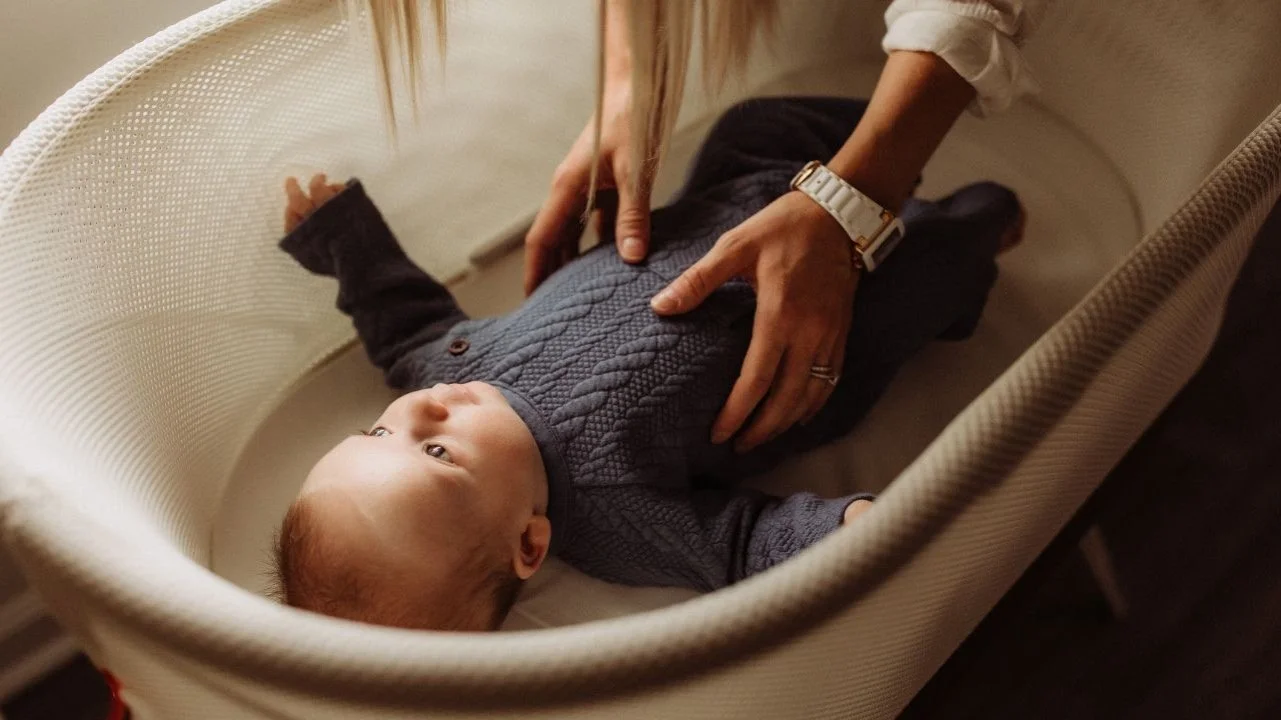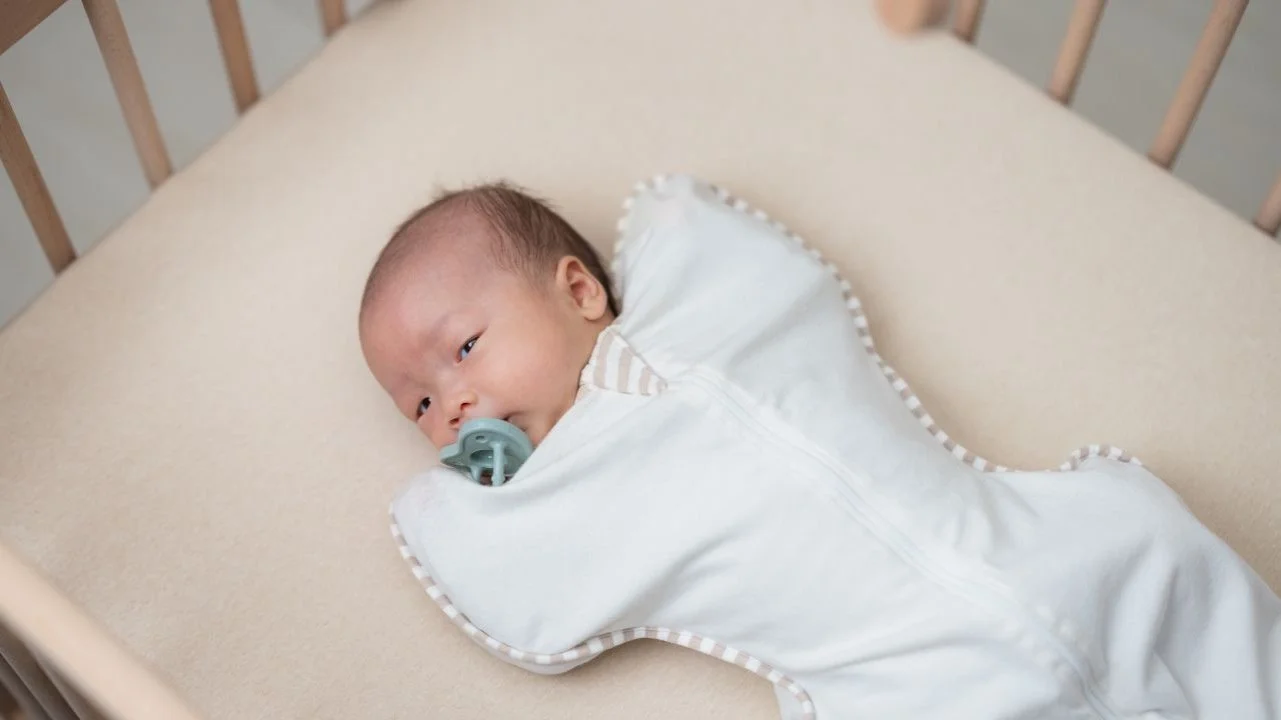Everything You Wish Someone Told You About Newborn Sleep
Newborn sleep! Let’s talk about it.
Whether you are currently in the thick of it, or you’re pregnant and totally stressing about the dreaded lack of sleep everyone keeps warning you is coming your way, you landed in the right place today!
As a postpartum doula and night nurse with a background in the NICU, I have cared for hundreds of babies in their first few weeks of life, and today I am sharing everything I know about how to maximize their sleep (and yours too)! This guide is definitely a deep dive and chock full of helpful info so be sure to pin this post to your Pinterest or bookmark this page so you can always come back and reference it!
Between unpredictable wakeups, short naps, and wondering why your baby is suddenly wide awake at 2 a.m., sleep can start to feel like the ultimate puzzle. If you’re feeling a little sleep-deprived and a lot overwhelmed, you are absolutely not alone! And I promise you are not doing anything wrong.
And while you can’t “perfect” a newborn’s sleep (their brains and bodies just aren’t ready for strict schedules yet), you can set up healthy foundations that:
Help your baby settle more easily
Support longer stretches of sleep when they’re ready
Give you more confidence and calm during those long days and nights
This post is your deep-dive guide to newborn sleep. Something you can come back to again and again. And if you want help turning this into a customized plan for your baby, I’ll show you how to do that at the end.
1. What’s “Normal” for Newborn Sleep? (Spoiler: You’re Not Messing It Up)
How much do newborns actually sleep?
In the first few weeks, most newborns sleep 14–17 hours in a 24-hour period, but it’s rarely in long, predictable stretches. It’s usually broken into lots of shorter chunks: sleep, feed, diaper, repeat.
Some babies seem to sleep constantly; others are more alert and curious. Both can be normal.
Why your newborn’s sleep feels so unpredictable
Newborns don’t have mature circadian rhythms yet (their internal clocks), so:
Day and night feel the same to them
Sleep cycles are short (about 40–50 minutes)
They need to wake frequently to feed
This is why consistent, 7–8 hour stretches aren’t realistic in the early weeks. You can absolutely make things smoother but expecting “perfect” nights right away is unrealistic and only adds pressure.
When do babies start sleeping longer stretches?
Every baby is different, but many start giving a longer stretch of sleep at night between 6–12 weeks, especially when:
They’re gaining weight well
You’ve helped them learn the difference between day and night
They have a predictable-ish bedtime routine and environment
My job is to help you gently lay that foundation now so later sleep training (if you choose to do it) is smoother and less stressful.
2. Safe Sleep Basics: The Non-Negotiables
Before we talk about routines or hacks, we have to talk safety. Safe sleep protects your baby and gives you peace of mind.
ABCs of safe sleep
Most pediatric and sleep organizations follow the ABCs of safe sleep:
A – Alone: Baby sleeps in their own sleep space (bassinet, crib, Pack ‘n Play), without pillows, blankets, bumpers, or stuffed animals.
B – Back: Always place baby on their back for sleep.
C – Crib: On a firm, flat surface with a tight-fitting sheet.
Room-sharing (baby in your room but not in your bed) is recommended for at least the first 6 months.
What should (and shouldn’t) be in the crib?
Safe to use:
Firm mattress with a fitted sheet
Pacifier (without a clip for sleep)
Wearable blanket or sleep sack
Avoid for sleep:
Loose blankets
Pillows
Positioners / wedges
Bumpers (even mesh ones)
Stuffed animals
Save the cute cozy stuff for awake time photos. It’s just not worth the risk for sleep.
Is it okay if my baby only sleeps on me?
Contact naps and snuggly sleep on you are incredibly normal and often necessary in the newborn phase. Many babies sleep best on a warm body that smells like their favorite person.
For safety, try to:
Keep contact naps to times when you are fully awake
Have another safe sleep space (bassinet, crib, Pack ’n Play) for when you feel drowsy
Gradually practice short stretches in the bassinet so your baby gets used to it
If your baby never tolerates the bassinet and you’re stuck in an unsafe sleep setup, that’s a great time to reach out for personalized support.
3. Setting Up a Calm, Cozy Sleep Environment
You don’t need a Pinterest-perfect nursery to have good sleep. You just need the basics done well.
Ideal room temperature for newborn sleep
Most babies sleep well in a room that’s around 68–72°F. It is always better for them to be a little too cold than too hot. There is a slightly terrifying saying, “a cold baby cries, a hot baby dies,” but it will help you remember the importance of not letting baby overheat while sleeping! A good rule of thumb: dress them in one more layer than you’re wearing.
Signs baby may be too hot: sweaty neck, damp hair, flushed cheeks.
Signs baby may be too cold: cold chest, hands and feet and a cool chest (hands and feet alone can be cooler and still be okay).
Lighting: teach day vs. night
For naps: use natural light or soft daylight. Dim but not pitch black for newborns is fine.
For night sleep: keep the room darker. Blackout curtains can really help once they’re a bit older, but in the newborn phase, aim for:
Low light
A tiny night-light for feeds and diaper changes
No bright overhead lights in the middle of the night
White noise: recreating the womb
Your baby just came from a very loud place (blood flow, heartbeat, digestion). Silence can actually feel unsettling.
Try:
A white noise machine or app
A box fan or air purifier
Keep it at a volume similar to a running shower and place it a few feet away from baby.
Safe sleepwear: swaddles and sleep sacks
Most newborns sleep best when they feel snug and contained.
Swaddle: Helps prevent the startle reflex from waking them. Always swaddle with hips free to move and place baby on their back. Use a Velcro-type swaddle versus a blanket for overnight sleep, as the blanket can come come undone and becomes a suffocation risk.
Sleep sack: A great option if they hate being swaddled or once they start to roll. Check out my favorite brand after using sleep sacks on a wide variety of newborn babies!
If you’re not sure what’s right for your baby or what’s safe by age, this is something I walk families through step-by-step in my sleep support guides.
4. Creating a Gentle Newborn Bedtime Routine
You can’t “train” a newborn in the strict sense, but you can start a simple routine that signals: “sleep is coming.”
Why a bedtime routine helps even for newborns
A consistent routine:
Gives baby familiar cues
Helps you feel more grounded and less chaotic
Can lead to smoother bedtime transitions over time
It’s basically a calm little sequence you repeat most nights, not a rigid schedule you have to follow perfectly.
Simple newborn bedtime routine (20–30 minutes)
Your routine might look like:
Dim lights + quiet play
Diaper change + pajamas
Short bath (optional, a few times a week)
Gentle massage or cuddle time
Feed
Burp & swaddle / sleep sack
Short cuddle, song, or lullaby
Lay down drowsy or asleep—both are okay in the newborn phase
What time should bedtime be?
In the early weeks, bedtime can be fairly late (9–11 p.m.) because newborns often have a “longer” stretch of sleep that shifts earlier as they grow.
Instead of chasing the “perfect” bedtime, aim for:
A routine that starts when baby has had a good feed
Watching their sleepy cues (more on that soon)
If bedtime always feels chaotic and stressful, a personalized routine can help you find a rhythm that fits your baby and your family.
5. Understanding Newborn Wake Windows & Sleep Cues
This is where a lot of parents feel lost! “Am I keeping them up too long? Not long enough?” Let’s get into it.
What are newborn wake windows?
A “wake window” is how long your baby is awake between sleeps.
In general:
0–4 weeks: 35–60 minutes
4–8 weeks: 45–90 minutes
This includes feeding, diaper changes, and a few minutes of “play” or snuggly awake time.
Sleep cues to watch for
Your baby will usually tell you they’re ready for sleep with cues like:
Red eyebrows
Staring off / glazed look
Slower movements
Yawning
Rubbing eyes or face
Fussiness that isn’t hunger
The sweet spot: putting them down when sleepy, not overtired. Once they’re screaming, arching, or wildly fighting sleep, they may be past that window and need extra soothing.
What happens if they get overtired?
Overtired babies:
Have a harder time falling asleep
May wake more often
Can seem wired and hyper (especially later in the day)
This is why honoring wake windows and cues can make a huge difference, even before you do any formal sleep training later.
6. Day vs. Night: Fixing Newborn Day/Night Confusion
Many newborns think 2 a.m. is party time. Totally normal, and fixable!
How to help baby understand daytime
During the day:
Open blinds and let natural light in
Get outside for a few minutes in the early part of the day (a short walk around the block, coffee on the porch, nothing crazy!)
Talk, sing, and engage during feeds
Don’t worry as much about noise! Normal household sounds are good
How to keep nighttime calm and under-stimulating
At night:
Keep lights very low
Use a tiny night-light instead of overhead lights
Speak softly and keep interactions minimal
Change diapers only when needed
Put baby back down after feeding and burping
Over time, those patterns help their internal clock learn that daytime is for playing and eating… and nighttime is for longer stretches of sleep.
7. Naps: Where, When, and How Long?
Newborn naps are often short, messy, and inconsistent. That’s okay. We’re aiming for “good enough,” not perfect.
How many naps does a newborn take?
In the first 8 weeks, newborns can take 4–8+ naps per day, often 20–90 minutes long.
Total daytime sleep will vary, but the more they sleep appropriately during the day, the less overtired and restless they’ll be at night.
Where should newborns nap?
Best case, naps can happen:
In a bassinet or crib
In a portable sleep space (like a Pack ’n Play)
On the go in a stroller or car seat (following car seat safety guidelines)
Contact naps (on your chest or in your arms) are absolutely okay and very normal. They help with bonding and can be a lifesaver during growth spurts.
A good balance: aim for a couple of naps per day in a safe, flat sleep space, and enjoy contact naps when you can.
When is it time to start a “nap schedule”?
In the first 6–8 weeks, focus more on:
Following wake windows
Watching cues
Offering sleep frequently
More predictable “nap schedules” usually come closer to 3–4 months. Which is exactly what I help families with inside my sleep support programs.
8. Feeding & Sleep: How They Work Together
Sleep and feeding are completely intertwined in the newborn phase.
Full feeds vs. snacking all day (and night)
Newborns often like to “snack,” especially if they’re sleepy at the breast or bottle. Frequent tiny feeds can:
Make it harder for them to sleep longer stretches
Leave you feeling like you’re feeding non-stop
Whenever you can, aim to:
Gently wake baby if they’re dozing off at the breast or bottle
Encourage a more complete feed (burp halfway through and offer more)
Then have a short wake window before sleep
Of course, if your pediatrician has specific feeding instructions (like waking to feed more often), always follow that guidance.
Is it okay to feed to sleep?
Yes, especially for newborns. Feeding is one of the most natural and powerful sleep tools you have.
You’re not “ruining” anything by nursing or bottle-feeding to sleep in the early weeks. Later, when baby is older and ready for more independent sleep skills, we can gently separate feeding from sleep if it’s causing issues.
Overnight feeds: what’s realistic?
Most newborns will need to feed every 2–3 hours overnight in the beginning. As they grow, gain weight, and your pediatrician gives the green light, they may naturally stretch some nighttime feeds.
If your baby is waking every hour and seems uncomfortable, gassy, or inconsolable, it may be less about “hunger” and more about something else going on—this is where individual support is so helpful.
9. Soothing Techniques That Actually Help
Some babies are chill sleepers from day one. Others need a little more help settling.
The “4 S’s” of soothing
You can try combinations of:
Swaddle – recreates the snug feeling of the womb
Shush – white noise or gentle “shhh” near baby’s ear
Swing / Sway – rhythmic rocking, bouncing, or walking
Suck – pacifier or feeding (if it’s time)
Not every baby likes every technique, and that’s okay. The magic is in noticing what works for your baby and using it consistently.
Pacifiers and sleep
Pacifiers can:
Help soothe baby between sleep cycles
Lower the risk of SIDS when used for sleep
Offer the pacifier when you’re putting baby down; if it falls out after they’re asleep, you don’t need to put it back in unless they’re fussing and want it.
10. Common Newborn Sleep Challenges (And What You Can Do)
You are not the only parent Googling these at 3 a.m., promise.
Witching hour: why evenings feel extra hard
Many babies have a “witching hour” (or hours) in the late afternoon or evening where they’re fussy, harder to soothe, and sleep feels impossible.
What can help:
Earlier, more frequent naps during the day
Offering a cluster feed in the evening
Wearing baby in a carrier and walking
Tag-teaming with a partner so you can take breaks
Gassiness and discomfort
If your baby seems uncomfortable lying flat:
Try more frequent burping during and after feeds
Keep them upright for 15–20 minutes after feeding
Watch for signs of reflux or allergy (talk to your pediatrician)
Sometimes what looks like “bad sleep” is really a comfort issue we can troubleshoot.
Growth spurts and developmental leaps
Expect sleep to go a bit sideways during:
Growth spurts (more frequent feeds, extra sleepy or extra fussy)
Big developmental changes (more alert, new skills)
Use your soothing tools, lean on your routine, and know that these phases do pass, even if it doesn’t feel like it at 2 a.m.
11. Sample Newborn Sleep Routines (0–8 Weeks)
These are not rigid schedules, just gentle examples to help you picture what a day could look like.
Example day with a 0–4 week old
7:00 a.m. – Wake & feed
7:45 a.m. – Back to sleep
9:30 a.m. – Wake & feed
10:15 a.m. – Nap
12:00 p.m. – Wake & feed
12:45 p.m. – Nap
2:30 p.m. – Wake & feed
3:15 p.m. – Nap
5:00 p.m. – Wake & feed
5:45 p.m. – Short nap or contact nap
7:00 p.m. – “Bedtime routine” + feed
7:45 p.m. – Down for night
Overnight – Feeds every 2–3 hours as needed
Some days will be messier, and that’s okay. Think of this as a framework, not a test you can fail.
When a custom routine helps
If your baby:
Catnaps all day and is up all night
Screams during every bedtime
Will only sleep on you, and you’re at a breaking point
…that’s a sign you don’t need to just “wait it out.” A customized routine and some hand-holding can make a massive difference.
12. When to Ask for Extra Help (You Don’t Have to DIY This)
You deserve sleep and support just as much as your baby does.
Signs you might benefit from professional sleep support
You dread nighttime and feel anxious as bedtime approaches
You and your partner are arguing about the “right” way to handle sleep
You’re so exhausted that basic daily tasks feel overwhelming
You’ve tried “all the tips” from friends and the internet and nothing is sticking
Newborn sleep doesn’t have to be perfect, but it also shouldn’t feel like constant chaos.
How I Can Support Your Baby’s Sleep
At Bring Home Bliss, I specialize in helping families find gentle, realistic sleep strategies that actually fit their lives, not someone else’s.
If you’re thinking, “I just wish someone would tell me exactly what to do for my baby,” that’s exactly what my services are designed to do!
Option 1: Personalized Newborn Sleep Routine
This is perfect if you want:
A custom daytime and nighttime rhythm based on your baby’s age, temperament, and feeding needs
Specific wake windows and nap ideas for your baby
A simple, repeatable bedtime routine
Guidance on swaddles, sleep sacks, and safe sleep setups
👉 Click here to get your personalized newborn sleep routine and start building healthier sleep habits—for your baby and for you.
Option 2: Newborn Sleep Support Program
If you want more hand-holding, my newborn sleep program includes:
Detailed, age-appropriate sleep plan
Messaging support so you can ask, “Is this normal?” in real time
Adjustments as your baby hits growth spurts or developmental changes
You do not have to figure this out alone, in the middle of the night, while scrolling your phone in tears.
👉 Click here to book your Newborn Schedule and Sleep Support where I answer all your questions and come up with a plan tailored to you and your family.
Final Thoughts: You’re Doing Better Than You Think
If you’ve made it this far, you care deeply about your baby’s wellbeing, and that alone makes you a good parent!
Newborn sleep is messy, temporary, and often humbling. You can’t control every wakeup, but you can:
Create a safe, cozy sleep space
Follow gentle wake windows and cues
Use simple routines and soothing tools
Ask for help when you’re overwhelmed
And I’m here to help you every step of the way.
👉 Ready for a custom newborn sleep routine and support tailored to your family? Book a Newborn Schedule and Sleep Support call with me today!
You and your baby deserve rest, and we can absolutely work toward more of it—together.











